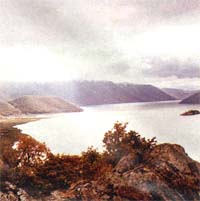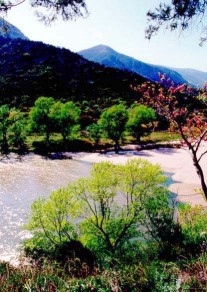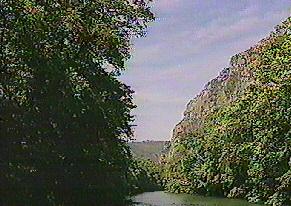Wetlands' functions
Written by
Elina Papagianaki
Tasoula Blazaki
Maria Garopoulou
Elpida Kourkoutaki
6th grade students
 Wetlands are ecosystems that perform many kinds of physical functions. Their knowledge is very important as it gives us the opportunity to define their values and to set a framework for an appropriate administration of these ecosystems. In a wetland one can discern the following functions:
Wetlands are ecosystems that perform many kinds of physical functions. Their knowledge is very important as it gives us the opportunity to define their values and to set a framework for an appropriate administration of these ecosystems. In a wetland one can discern the following functions:
* Subterranean aquatic layer enrichment
* Flood modification
* Sediment entrapment
* Carbon dioxide (CO2) absorption
* Temperature accumulation and release
* Solar radiation absorption
A wetland can perform one or more of these functions in different degrees, ways or periods. What is really important is that they impact not only on the neighboring areas but on the whole region.
 Subterranean aquatic layer enrichment. Wetlands are characterized by the vertical and (sometimes) horizontal water flow towards (or from) their underground layers. Some derive their waters from these basins while others enrich them, depending mainly on the soil's composition and the weather conditions, especially the amount of rainfalls. Nevertheless, this function is very important, as wetlands become water deposits, which supply us with fresh water. And as we know water is becoming more and more precious. Population explosion and human intervention are the main reasons.
Subterranean aquatic layer enrichment. Wetlands are characterized by the vertical and (sometimes) horizontal water flow towards (or from) their underground layers. Some derive their waters from these basins while others enrich them, depending mainly on the soil's composition and the weather conditions, especially the amount of rainfalls. Nevertheless, this function is very important, as wetlands become water deposits, which supply us with fresh water. And as we know water is becoming more and more precious. Population explosion and human intervention are the main reasons.
Flood modification. A wetland can alter the intention of a flood, which is caused by a storm or thaw, either by decreasing the total water volume or by slowing down the water flow. As mentioned before they distribute part of their waters to the subterranean layers and so great amount of waters are stored in the ground minimizing the water volume. Furthermore, the rich vegetation of the ecotope sustains the intention of the water flow.
Sediment entrapment. The waters of torrents, rivers and streams, however clear they seem to be, contain many different kinds of substances, other dissolved in the waters while other wavering in them. Their rich vegetation acts as a trap for these substances. By slowing down the water flow the sediments immerse in the bottom. These sediments and rocks are sometimes rich in minerals nutritious for plants and other organisms (phytoplankton, microorganisms).
Carbon dioxide (CO2) absorption.  There has been an increase in the amount of carbon dioxide in the atmosphere, during the last 200 years, with the outbreak of the industrial explosion. Activities, such as mineral burning (mainly oil) for industrial use, energy production, transportation and heating, in conjunction with deforestation and flora destruction, have resulted in releasing great amounts of carbon dioxide in the planet's atmosphere. Carbon dioxide doesn't only pose a scientific interest but raises great environmental concern because of its attributes. Just like glass it allows solar radiation enter whereas it obstructs thermal radiation to exit. As a result the atmosphere's temperature raises, a phenomenon called the greenhouse effect. The hydrosphere accumulates much of this amount of carbon dioxide with beneficial effects for the global climate.
There has been an increase in the amount of carbon dioxide in the atmosphere, during the last 200 years, with the outbreak of the industrial explosion. Activities, such as mineral burning (mainly oil) for industrial use, energy production, transportation and heating, in conjunction with deforestation and flora destruction, have resulted in releasing great amounts of carbon dioxide in the planet's atmosphere. Carbon dioxide doesn't only pose a scientific interest but raises great environmental concern because of its attributes. Just like glass it allows solar radiation enter whereas it obstructs thermal radiation to exit. As a result the atmosphere's temperature raises, a phenomenon called the greenhouse effect. The hydrosphere accumulates much of this amount of carbon dioxide with beneficial effects for the global climate.
Temperature accumulation and release. Water has unique thermal attributes. Firstly it has high specific heat, meaning that great amounts of calories are needed to increase or decrease its temperature.  We can say that, in a way, oceans, seas and lakes function as temperature deposits, a fact that contributes to the maintenance of the atmospheric temperature in an appropriate for life existence level. Wetlands perform the same function in a lower of course degree, impacting the microclimate in areas of water. We bear witness to this, as temperature differences between night and day or summer and winter, are quite small in regions where water is predominant (littoral or riverside cities) .
We can say that, in a way, oceans, seas and lakes function as temperature deposits, a fact that contributes to the maintenance of the atmospheric temperature in an appropriate for life existence level. Wetlands perform the same function in a lower of course degree, impacting the microclimate in areas of water. We bear witness to this, as temperature differences between night and day or summer and winter, are quite small in regions where water is predominant (littoral or riverside cities) .
Solar radiation absorption. Many kinds of self-feeding organisms that inhabit in wetlands such as bushes, trees, underwater plants and microorganisms absorb solar radiation. All the plants that root in wetlands are designated aquatic and the vegetation they form aquatic flora. The self-feeding organisms that waver in the waters are in general called phytoplankton. Many people believe that wetlands are the most productive ecosystems in the planet. And this because they produce the highest amounts of oxygen per square meter while they absorb analogous carbon dioxide. Actually very productive are those wetlands that their waters are frequently renewed by floods and rivers and are rich in minerals.

home page
 Wetlands are ecosystems that perform many kinds of physical functions. Their knowledge is very important as it gives us the opportunity to define their values and to set a framework for an appropriate administration of these ecosystems. In a wetland one can discern the following functions:
Wetlands are ecosystems that perform many kinds of physical functions. Their knowledge is very important as it gives us the opportunity to define their values and to set a framework for an appropriate administration of these ecosystems. In a wetland one can discern the following functions:  Subterranean aquatic layer enrichment. Wetlands are characterized by the vertical and (sometimes) horizontal water flow towards (or from) their underground layers. Some derive their waters from these basins while others enrich them, depending mainly on the soil's composition and the weather conditions, especially the amount of rainfalls. Nevertheless, this function is very important, as wetlands become water deposits, which supply us with fresh water. And as we know water is becoming more and more precious. Population explosion and human intervention are the main reasons.
Subterranean aquatic layer enrichment. Wetlands are characterized by the vertical and (sometimes) horizontal water flow towards (or from) their underground layers. Some derive their waters from these basins while others enrich them, depending mainly on the soil's composition and the weather conditions, especially the amount of rainfalls. Nevertheless, this function is very important, as wetlands become water deposits, which supply us with fresh water. And as we know water is becoming more and more precious. Population explosion and human intervention are the main reasons.  There has been an increase in the amount of carbon dioxide in the atmosphere, during the last 200 years, with the outbreak of the industrial explosion. Activities, such as mineral burning (mainly oil) for industrial use, energy production, transportation and heating, in conjunction with deforestation and flora destruction, have resulted in releasing great amounts of carbon dioxide in the planet's atmosphere. Carbon dioxide doesn't only pose a scientific interest but raises great environmental concern because of its attributes. Just like glass it allows solar radiation enter whereas it obstructs thermal radiation to exit. As a result the atmosphere's temperature raises, a phenomenon called the greenhouse effect. The hydrosphere accumulates much of this amount of carbon dioxide with beneficial effects for the global climate.
There has been an increase in the amount of carbon dioxide in the atmosphere, during the last 200 years, with the outbreak of the industrial explosion. Activities, such as mineral burning (mainly oil) for industrial use, energy production, transportation and heating, in conjunction with deforestation and flora destruction, have resulted in releasing great amounts of carbon dioxide in the planet's atmosphere. Carbon dioxide doesn't only pose a scientific interest but raises great environmental concern because of its attributes. Just like glass it allows solar radiation enter whereas it obstructs thermal radiation to exit. As a result the atmosphere's temperature raises, a phenomenon called the greenhouse effect. The hydrosphere accumulates much of this amount of carbon dioxide with beneficial effects for the global climate.  We can say that, in a way, oceans, seas and lakes function as temperature deposits, a fact that contributes to the maintenance of the atmospheric temperature in an appropriate for life existence level. Wetlands perform the same function in a lower of course degree, impacting the microclimate in areas of water. We bear witness to this, as temperature differences between night and day or summer and winter, are quite small in regions where water is predominant (littoral or riverside cities) .
We can say that, in a way, oceans, seas and lakes function as temperature deposits, a fact that contributes to the maintenance of the atmospheric temperature in an appropriate for life existence level. Wetlands perform the same function in a lower of course degree, impacting the microclimate in areas of water. We bear witness to this, as temperature differences between night and day or summer and winter, are quite small in regions where water is predominant (littoral or riverside cities) .